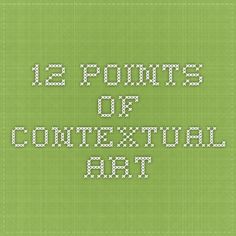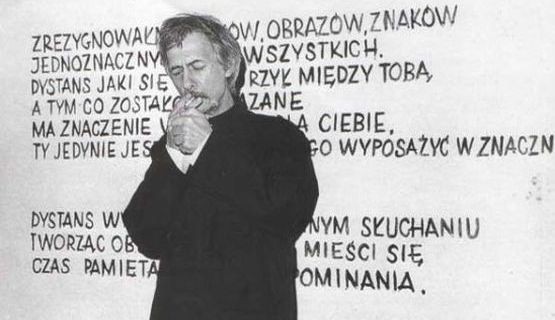from Jan Świdziński’s excellent website: www.swidzinski.art.pl
l. There are no objects without a meaning as there are no meanings without objects. One and the same object may have different meanings in different codes, one and the same meaning may be ascribed to different objects. All this leads to two types of multi-meaning:
i. The multi-meaning of objects which have the same meaning.
ii. The multi-meaning of meanings which have the same object.
In a particular context only one meaning is accepted as the true one. The criterion of choice is the criterion of truth.
2. If different social groups ascribe different meanings to one and the same object and one of those groups commands sufficient authority to enforce its viewpoint on others, the problem arises of finding a suitable criterion of choice. This leads to the many definitions of art (everything may be art).
Since civilization is changing extremely fast today, there is little time for new meanings of objects to crystallize. In effect the objects of art assume different meanings (everything may be accepted as art).
3. In our practical activities we create objects with a given meaning (concepts). This is how conventional art works.
In our cognitive activities we create meanings (concepts) possessing given objects. This is how conceptual art works.
Both of these operations have a feedback relation. The reality that we shape depends on our concepts of reality, our concepts of reality depend on the reality that we create. Therefore the choice of criterion defines the reality that we shape.
4. The changes that occur in that reality make the existing meanings no longer valid; social practice becomes the ultimate criterion. The fact that certain meanings lose their validity affects our life-styles, results in a loss of privileges that have been gained by one group in favour of another. There is therefore a constant trend towards upholding meanings which have lost their validity. Because of the diversified range of meanings in the definition systems, there is the possibility of constructing apparent meanings of reality, and in consequence, of producing an apparent reality.
5. The outdating of meanings is a constant process – proceeding all the faster the quicker civilization changes.
Contextual art proposes a sign, the criterion of truth of which, defined by the pragmatic context, changes incessantly (a situation develops in which “p” begins to be “p” – begins not to be “p”). Object “O” assumes the meaning “m” in time “t,” place “p,” situation “s,” in relation to the person/persons “x” then and only then. A change of any of those elements outdates the previous meaning.
6. The operation of contextual art is therefore a steady rejection of canons used to arrest the outdating of meanings.
7. Contextual art opposes the stabilization of the objects of art, since the lasting nature of an object extends into its meaning.
Contextual art opposes the stabilization of meanings, since the lasting nature of meanings leads to the production of outdated objects. It therefore rejects the definitions of art.
8. In the relation linking meaning and the object to which U is applied, in the case of conventional art both components remain stable (“art” implies these and not any other objects).
Since Duchamp’s time, the second of these components has been set into motion (every object may mean an art).
In contextual art both components change (also each object may have the meaning of an “art” and not be an art). The aim of art is the relativization of the entire area of meanings and of objects.
9. Art as contextual art is concerned with the relation itself (the readiness to reup the meaning of the object in a defined pragmatic context).
10. The expressions of contextual art are not expressions which would be acceptable to a group since the reality construed by the artist is something different than that which is received. (It changes all the time).
11. Art as contextual art has no connection with science. Science has to define (immobilize) an object by giving its meaning. It is beyond the sphere of formal logic. The world in which it exists is not an area of formalized axioms, but rules which become constantly outdated and which attempts to preserve the changing reality.
12. Art as contextual art is opposed to multi-meaning and also to relativism. One and only one expression is true in the given pragmatic context. Such expression is expressed with assertion.

